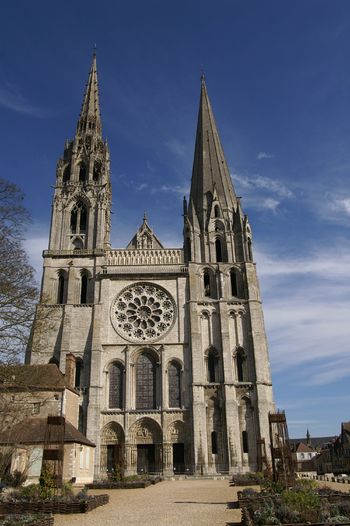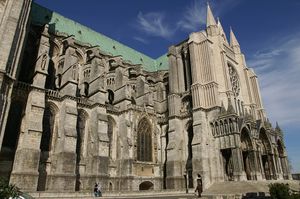Chartres Cathedral: Difference between revisions
imported>Chunbum Park mNo edit summary |
John Leach (talk | contribs) m (Text replacement - "World Heritage Site" to "World Heritage site") |
||
| (9 intermediate revisions by 2 users not shown) | |||
| Line 1: | Line 1: | ||
{{subpages}} | {{subpages}} | ||
{{Image|Chartres Cathedral | {{Image|Chartres Cathedral main entrance, 2010.jpg|right|350px|The front of the cathedral at Chartres.}} | ||
'''Chartres Cathedral''' (''Cathédrale Notre-Dame de Chartres''<ref name="deparis">''Cathédrale Notre-Dame de Chartres'', which translates as '''Cathedral of Our Lady of Chartres''', is different from ''Cathédrale Notre-Dame de Paris'', which is colloquially known as [[Notre Dame de Paris]]</ref>) is a great [[cathedral]] in [[Chartres]], [[France]]. | '''Chartres Cathedral''' (''Cathédrale Notre-Dame de Chartres''<ref name="deparis">''Cathédrale Notre-Dame de Chartres'', which translates as '''Cathedral of Our Lady of Chartres''', is different from ''Cathédrale Notre-Dame de Paris'', which is colloquially known as [[Notre Dame de Paris]]</ref>) is a great [[cathedral]] in [[Chartres]], [[France]]. The current structure dates from the 12th century and was built in the [[Gothic architecture|Gothic architectural style]] over the burned ruins of a previous wood-roofed [[Romanesque architecture|Romanesque]] cathedral.<ref name="kostof338">Kostof, 1985. pp. 338</ref> | ||
== History == | |||
The | The town of Chartres, then known by its Latin name ''Carnotum'', became the seat of a bishop in the 5th century. Therefore the church at which he was based became a cathedral. The form of Chartres' early cathedral is uncertain, although it was most likely built primarily with timber. By at least the 8th century it was dedicated to the [[Virgin Mary]]. The cathedral was looted by the Duke of Aquitaine in 753, and by [[Vikings]] more than a century later in 858.<ref>Ball, 2009, p. 16</ref> | ||
The | The church was the center of [[Mariolatry]] in France as it housed a gift acquired from [[Constantinople]] by [[Carolingian Empire|Carolingian King]] [[Charles the Bald]], which was presumed to be the tunic worn by the Virgin Mary at [[Jesus]]'s [[Nativity of Jesus|nativity]].<ref name="kostof333">Kostof, 1985. pp. 333</ref> Charles donated the tunic to the Bishop of Chartres in 876; the relic offered some protection to the Cathedral, so that when Vikings again attacked in 911 they turned away and left the city. However, the timber structure was vulnerable to fire and it burnt to the ground in 1020 and was rebuilt in a "state of wondrous greatness and beauty".<ref>Ball, 2009, pp. 8, 16–17</ref> | ||
=== | On June 10, 1194, fire raged across Chartres and the 11th-century Cathedral was severely damaged.<ref>Ball, 2009, p. 20</ref> The old choir and the new facade that was begun in the previous year survived the fire, which also befell on a large part of the town on June 10, 1194, and along with them the tunic, which was preserved in the crypt below the Romanesque choir. With the priests' explanation to the townspeople that Mary wished to be restored in even greater magnificence, construction started anew right away.<ref name="kostof338"/> | ||
{{Image|Chartres Cathedral south side, 2010.jpg|left|300px|The south side of the cathedral}} | |||
The Cathedral was consecrated in 1220, and services were held amidst the ongoing construction work which continued well until 1250.<ref name="kostof338"/> Since 1979 the cathedral has been designated by [[UNESCO]] as a [[World Heritage site]].<ref>[http://whc.unesco.org/en/list/81 Chartres Cathedral], UNESCO. Accessed 27 December 2012.</ref> | |||
== Architecture == | |||
The limit placed on the [[nave]]'s length by the [[fault (geology)|fault]] that occurs to the east was made up for in height. In its transformation to the gothic style, the cathedral was given a new twin-tower facade with a large [[rose window]] which was installed above the three [[lancet window|lancet]]s of the new vestibule built before the fire, and an outer [[ambulatory]] was placed through the inner side of the Romanesque radiating chapels, making them protrude less.<ref name="kostof338"/> | |||
== Notes == | |||
{{reflist}} | {{reflist}} | ||
Latest revision as of 10:34, 7 March 2024
Chartres Cathedral (Cathédrale Notre-Dame de Chartres[1]) is a great cathedral in Chartres, France. The current structure dates from the 12th century and was built in the Gothic architectural style over the burned ruins of a previous wood-roofed Romanesque cathedral.[2]
History
The town of Chartres, then known by its Latin name Carnotum, became the seat of a bishop in the 5th century. Therefore the church at which he was based became a cathedral. The form of Chartres' early cathedral is uncertain, although it was most likely built primarily with timber. By at least the 8th century it was dedicated to the Virgin Mary. The cathedral was looted by the Duke of Aquitaine in 753, and by Vikings more than a century later in 858.[3]
The church was the center of Mariolatry in France as it housed a gift acquired from Constantinople by Carolingian King Charles the Bald, which was presumed to be the tunic worn by the Virgin Mary at Jesus's nativity.[4] Charles donated the tunic to the Bishop of Chartres in 876; the relic offered some protection to the Cathedral, so that when Vikings again attacked in 911 they turned away and left the city. However, the timber structure was vulnerable to fire and it burnt to the ground in 1020 and was rebuilt in a "state of wondrous greatness and beauty".[5]
On June 10, 1194, fire raged across Chartres and the 11th-century Cathedral was severely damaged.[6] The old choir and the new facade that was begun in the previous year survived the fire, which also befell on a large part of the town on June 10, 1194, and along with them the tunic, which was preserved in the crypt below the Romanesque choir. With the priests' explanation to the townspeople that Mary wished to be restored in even greater magnificence, construction started anew right away.[2]
The Cathedral was consecrated in 1220, and services were held amidst the ongoing construction work which continued well until 1250.[2] Since 1979 the cathedral has been designated by UNESCO as a World Heritage site.[7]
Architecture
The limit placed on the nave's length by the fault that occurs to the east was made up for in height. In its transformation to the gothic style, the cathedral was given a new twin-tower facade with a large rose window which was installed above the three lancets of the new vestibule built before the fire, and an outer ambulatory was placed through the inner side of the Romanesque radiating chapels, making them protrude less.[2]
Notes
- ↑ Cathédrale Notre-Dame de Chartres, which translates as Cathedral of Our Lady of Chartres, is different from Cathédrale Notre-Dame de Paris, which is colloquially known as Notre Dame de Paris
- ↑ 2.0 2.1 2.2 2.3 Kostof, 1985. pp. 338
- ↑ Ball, 2009, p. 16
- ↑ Kostof, 1985. pp. 333
- ↑ Ball, 2009, pp. 8, 16–17
- ↑ Ball, 2009, p. 20
- ↑ Chartres Cathedral, UNESCO. Accessed 27 December 2012.

